national parks in the country by the first half of this year. He said, clearing of land mines in Wilpattu has reached its final stages and the Ministry will have opened the the Park by February. “With the opening of the national parks , Sri Lanka’s tourist industry can rely on Eco tourism. This will directly influence the country’s economic development with locla community to derive direct benefits There will be more business opportunities for investors,” said Minister Ranawaka. The Minister was speaking at the opening ceremony of the Kumana National Park, which took place in Okanda. Minister of Natural Resources Indika Bandara, Wildlife Conservation Deparment Director General W.A.D.Wijesuriya, Park Wardens of Wildlife sanctuaries, Principals and children from nearby village schools in Okanda area, were present on this occasion. It was interesting to see that a group of indigenous people (Vannile Aththo) have come to greet Minister Champika Ranawaka and the Willdlife authorities on this occasion. The leader of the Wannila Aththo was also present. They invoked blessings of their Forest God Kalu Bandara on Minister Ranawaka whom they called the minister Maha Hura and chanted religious versus in harmony that lasted for ten minutes. An exchange of gifts took place between the minister and the Wannila Attho after after the ritual. The sky was whiter than usual as the the brightly shining sun surveyed the plains of Kumana that Saturday. Yet there were short spells of rains in spite of the sun’s bright dominance in the sky. rains sometimes cover the jeep road of the Park that leads to its bird sanctuary on a 200 hectare natural swamp lake. This is one of the most significant features of the park called Kumana villu. It is fed by Kumbukkan estuary through a half a mile long narrow channel. Although our crew could not see much bird population at this mangrove swamp this time of the year, a Park Warden said that most birds had flown away because there have been too much disturbance in the forest with the noise of too many safari jeeps plying down the area. Most water birds come to nest in the swamp in May and June.
A hawk-eyed traveller always gets manges to get a glimpse of a very rare black-necked stork or a Lesser Adjutant in this areas. The prolific birdlife in Kumana sancturay include Eurasian Spoonbill and Great Thick-knee. Kumana villu is occasionally inundated with sea water. Besides these migratory bird species, the park is home for birds such as pelicans, painted storks, spoonbills, white ibis, herons, egrets and little cormorants. They were to be seen along the riverine banks of the sanctuary with 20 lagoons and tanks. Tens of thousands of birds migrate to the sanctuary during April and July. There are about 255 speciebird species to have been dected in Kumana, among them waders belonging to families of Scolopacidae and Charadriidae. These birds visit the sanctuary with waterfowl, Pintail Snipes, migrating after flying 9,000 kilometers to 11,000 kilometres from Siberia. The park are of Kumana is 18,196 hectares with wetlands covering 626 hectares. River Valley Civilizations Vegetation in Kumana consists mainly of mangrove trees, kumbuk trees and karan fern. The streams Alakola Ara and other streams flow to the Kumbukkan oya. Smaller streams such as the Girikula and Bagura Ara flow to the lagoons. The lagoons are less than two meters deep. The lagoons include Bagura Kalapuwa (154 ha), Andarakala, Itikala and Yakkala (272 ha). Lying within the low country dry zone the mean temperature of the Park is 27.30C and the average annual rainfall is around 1300 mm. The records of Sri Lanka’s ancient river valley civilizations are also found in the Panama area of Kumana. Rock inscriptions belonging to the second and first centuries B.C., providing substantial evidence in this concern, have been found in this region .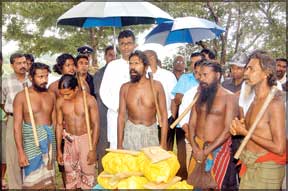
Indigenous people of Sri Lanka (Wannile Aththo) meet Environment Minister Champika Ranawaka at the Kumana National Park opening.
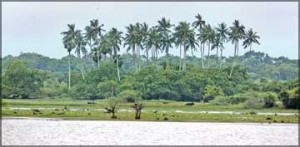
Kumana river valley civilization. It was belived that there was a village among these coconut trees and people lived here 100,000 years ago
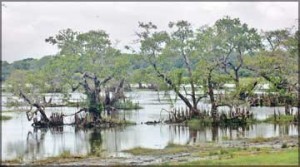
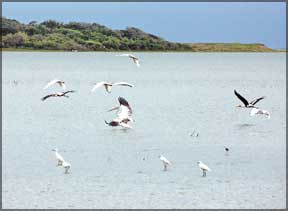
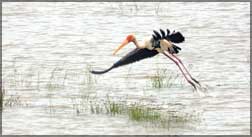


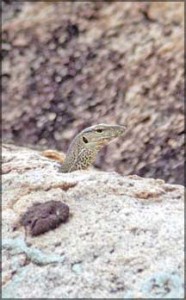
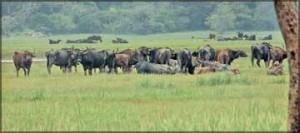
 Arugam Forum
Arugam Forum Arugam Photo Galleries on Picasa
Arugam Photo Galleries on Picasa Old Website
Old Website Press Coverage
Press Coverage Surf Forecast for Arugam Bay
Surf Forecast for Arugam Bay
True. Arugam Bay is a very Nice place. More tourists are expected.
But please use your real name and e-mail in future. Mr. Thaseem.
You are then welcome to contribute to any discussion! (Admin)
i am thaseem i have hotel land arugambay,sri lanka im looking for foriner partnership the benifit 50%+50% both
any one like well come arugambay And send me mail :m.thaseem@yahoo.com ok byee
hi arugambay now more tourest coming nice place i am vrey happy and well come arugambay
Very happy to hear that National Parks such as Kumana are being made accessible to the general public. Hats off to the authorities concerned.Looking forward to seeing for our selves, sights that were limited to our geography text books only, for the past 20 or more years…
Glad to hear the park has reopened. Hope everything goes well.